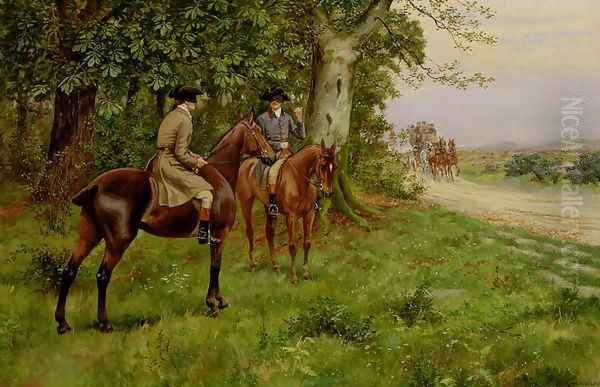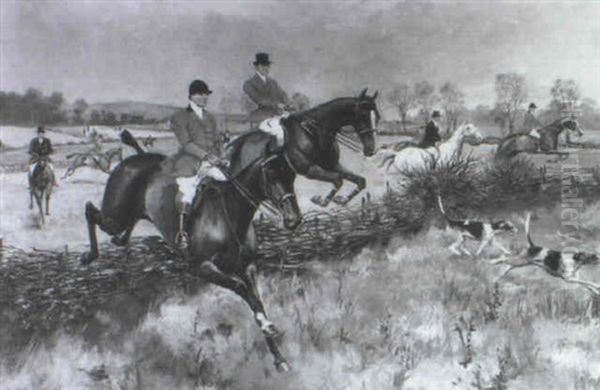George Derville Rowlandson (1861-1930) stands as a significant figure within the rich tradition of British sporting and equestrian art. Active during the late nineteenth and early twentieth centuries, his work captured the dynamism and elegance of horses, particularly within the contexts of hunting and rural life. Though perhaps not as widely known today as some titans of the genre, Rowlandson developed a distinct style and produced a body of work appreciated by enthusiasts of equestrian pursuits and fine watercolour painting. His contributions offer a valuable window into the sporting culture of Edwardian Britain.
His era followed a long line of artists dedicated to equine subjects. The groundwork laid by masters such as George Stubbs in the 18th century, with his unparalleled anatomical understanding, and the dynamic compositions of Benjamin Marshall, set a high standard. Later, the popularity of racing and hunting scenes continued with artists like John Frederick Herring Sr. and his son, John Frederick Herring Jr., ensuring that the horse remained a central figure in British art through the 19th century. Rowlandson entered this established field, bringing his own perspective.
The Heart of the Hunt: Rowlandson's Artistic Focus
Rowlandson carved a niche for himself primarily through his depictions of equestrian activities, with a strong emphasis on hunting scenes. Fox hunting, in particular, was a popular and socially significant pastime in the British countryside during his lifetime, and it provided fertile ground for artistic representation. His works often go beyond simple portraiture, capturing the energy and movement inherent in the chase, the relationship between rider and mount, and the atmosphere of the rural landscape.
His dedication to these themes is evident in well-known works. He seemed particularly adept at portraying horses in motion, understanding their anatomy and translating their power and grace into his compositions. Whether depicting a quiet moment before the hunt or the full cry of the chase across fields and fences, Rowlandson’s focus remained on the authentic portrayal of the equestrian world. This specialization resonated with a clientele deeply involved in country sports.
Style and Watercolour Mastery

George Derville Rowlandson predominantly worked in watercolour, a medium well-suited to capturing the light and atmosphere of the British landscape. His technique is often described as fine and detailed, allowing for precision in rendering the musculature of horses, the textures of riding attire, and the nuances of the natural environment. While detailed, his work often retains a sense of liveliness and immediacy, crucial for depicting the fast-paced action of a hunt or the spirited movement of a horse.
The source material notes his series Foxhunting Scenes was executed in watercolour, completed before 1920. This medium, handled with skill, can convey both the crispness of a frosty morning meet and the muddier, more strenuous aspects of a long run across country. Rowlandson's ability to capture the specific mood and "British countryside atmosphere" was a key element of his appeal, situating his subjects convincingly within their environment. His approach contrasts with the bolder, sometimes looser, oil techniques favoured by contemporaries like Sir Alfred Munnings, yet shares a common goal of celebrating equine beauty and sporting life.
Representative Works and Recognition
Among Rowlandson's most recognized works is the series titled Foxhunting Scenes. Described as a set of twelve watercolour paintings, each signed in ink, this collection reportedly depicted the hunt from its beginnings ("From Scent to View"), showcasing the narrative progression of the event. Such series were popular, allowing viewers to follow the story and appreciate the different facets of the hunt. These works, completed before 1920, exemplify his commitment to the theme and his proficiency in watercolour.
Another notable painting mentioned is The Highwaymen. While the specific details of this composition are not provided in the source text, the title suggests a historical or romanticized scene, likely featuring horses prominently, perhaps capturing a dramatic roadside encounter. Such subjects, blending history with equestrian elements, also found favour with audiences. Furthermore, the record of a work titled A Heavy Load being sold at auction in 1900 for £80 indicates his participation and recognition within the art market of his time.
Rowlandson's skill earned him recognition beyond British shores. Notably, his work is held in the collection of the Museum of Polo and Hall of Fame in Lake Worth, Florida. This inclusion underscores his reputation specifically within the international equestrian community, confirming his status as a painter whose depictions of horses resonated with those most knowledgeable about the subject. His paintings also appeared at major auction houses like Christie's, further attesting to their perceived value and collectability over the years.
Rowlandson in Context: Contemporaries and Genre

George Derville Rowlandson worked during a vibrant period for British sporting art. He was a contemporary of several renowned artists who also specialized in equestrian and animal subjects. Sir Alfred Munnings, perhaps the most celebrated British equestrian artist of the 20th century, was known for his vigorous oil paintings of racehorses, hunts, and rural life. Lionel Edwards and Cecil Aldin were also highly popular, known for their hunting scenes and often capturing the humorous or characterful aspects of country sports.
Charles Johnson Payne, better known as 'Snaffles', created distinctive prints and watercolours, often with witty captions, focusing on military and sporting themes, particularly hunting and polo. Artists like Heywood Hardy also contributed significantly to sporting and animal painting in the late 19th and early 20th centuries. While Rowlandson's style might be seen as perhaps less flamboyant than Munnings or less stylized than Snaffles, his work holds its own through its careful execution and authentic feel.
The enduring appeal of wildlife and animal art, represented earlier by figures like Sir Edwin Landseer (though Landseer died before Rowlandson's career fully flourished, his influence was pervasive) and continued by specialists like Archibald Thorburn (known for birds), provided a broad context for Rowlandson's specialization. The market for sporting art was robust, supported by landowners, hunt members, and racing enthusiasts who wished to see their passions reflected in art. Rowlandson successfully catered to this demand.
Legacy in Sporting Art
George Derville Rowlandson's legacy lies in his contribution to the specific genre of British equestrian and sporting art. He operated within a well-established tradition, bringing his own skills in watercolour and observation to bear on subjects he clearly knew well. His paintings serve as visual documents of the hunting and equestrian culture of his time, rendered with an eye for detail and a feel for the movement and spirit of the horse.
While detailed biographical information, particularly regarding his early life, training, or specific interactions with other artists, appears scarce or confused in some readily available summaries (which sometimes conflate him with the earlier, famous caricaturist Thomas Rowlandson, or other individuals), his artistic output speaks for itself. The consistent focus on equestrian themes, the proficiency in watercolour, and the recognition his work achieved both during his lifetime and posthumously, secure his place as a respected painter of the British sporting scene. His works continue to be appreciated by collectors and enthusiasts of equestrian art today.